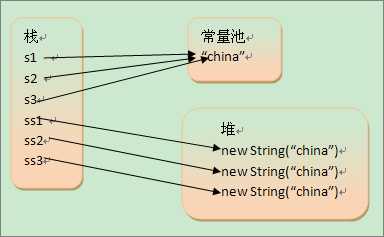标签:image 自动 改变 常量池 ima int str1 == 分享
Java中内存分析:

1)
String a = "abc";① String b = "abc";②
分析:
①代码执行后在常量池(constant pool)中创建了一个值为abc的String对象。
②执行时,因为常量池中存在"abc"所以就不再创建新的String对象了。
String c = new String("xyz");①
String d = new String("xyz");②
分析:
①Class被加载时,"xyz"被作为常量读入,在常量池(constant pool)里创建了一个共享的值为"xyz"的String对象;然后当调用到new String("xyz")的时候,会在堆(heap)里创建这个new String("xyz")对象;
②由于常量池(constant pool)中存在"xyz"所以不再创建"xyz",然后创建新的new String("xyz")。
3)
String s1 = new String("xyz"); //创建二个对象(常量池和堆中),一个引用
String s2 = new String("xyz"); //创建一个对象(堆中),并且以后每执行一次创建一个对象,一个引用
String s3 = "xyz"; //创建一个对象(常量池中),一个引用
String s4 = "xyz"; //不创建对象(共享上次常量池中的数据),只是创建一个新的引用
4)
1 public class TestStr { 2 public static void main(String[] args) { 3 // 以下两条语句创建了1个对象。"凤山"存储在字符串常量池中 4 String str1 = "凤山"; 5 String str2 = "凤山"; 6 System.out.println(str1==str2);//true 7 8 //以下两条语句创建了3个对象。"天峨",存储在字符串常量池中,两个new String()对象存储在堆内存中 9 String str3 = new String("天峨"); 10 String str4 = new String("天峨"); 11 System.out.println(str3==str4);//false 12 13 //以下两条语句创建了1个对象。9是存储在栈内存中 14 int i = 9; 15 int j = 9; 16 System.out.println(i==j);//true 17 18 //由于没有了装箱,以下两条语句创建了2个对象。两个1对象存储在堆内存中 19 Integer l1 = new Integer(1); 20 Integer k1 = new Integer(1); 21 System.out.println(l1==k1);//false 22 //以下两条语句创建了1个对象。1对象存储在栈内存中。自动装箱时对于值从127之间的值,使用一个实例。 23 Integer l = 20;//装箱 24 Integer k = 20;//装箱 25 System.out.println(l==k);//true 26 //以下两条语句创建了2个对象。i1,i2变量存储在栈内存中,两个256对象存储在堆内存中 27 Integer i1 = 256; 28 Integer i2 = 256; 29 System.out.println(i1==i2);//false 30 } 31 }
标签:image 自动 改变 常量池 ima int str1 == 分享
原文地址:http://www.cnblogs.com/ganchuanpu/p/7679576.html